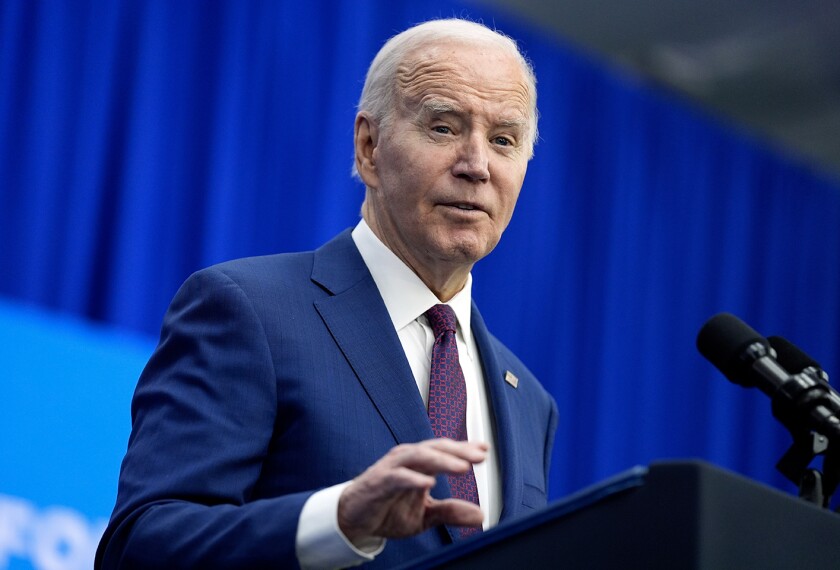Congress has essentially ignored President Donald Trump’s previous education spending blueprints and approved relatively small overall increases for the U.S. Department of Education in each of the past three federal appropriations bills. There’s no particular reason to think Capitol Hill will treat his latest budget proposal much differently.
But the president’s plan to shrink U.S. Department of Education funding by nearly 8 percent in part by consolidating 29 major programs—including Title I aid for disadvantaged students and funding for charter school expansion—into a single, $19.4 billion block grant is still managing to kick up plenty of dust.
U.S. Secretary of Education Betsy DeVos and other Education Department officials say the grant would provide states with newfound flexibility. “Different states will spend their share of the block grant differently, and that’s OK,” DeVos said during a presentation of the spending proposal earlier this month. “In fact, that’s what we hope they will do.”
In a presentation on the budget, the department highlighted that states could support charter schools with their block grants.
Others, however, focused on the overall funding cut and the end to several line-item programs in the proposal, which would reduce the Education Department’s budget by $5.6 billion, lowering it to $66.6 billion.
Daniel Domenech, the executive director of AASA, the School Superintendents Association, said in a statement that, “Once again, unsurprisingly, the president has released a budget proposal that is bad for students, bad for schools, and bad for public education.”
And charter advocates, who in past years saw the Trump administration try to increase money for charter school expansion, panned the proposal to fold that program into a new block grant.
“Secretary DeVos wants to be known as the secretary who has promoted school choice,” said Nina Rees, the president and CEO of the National Alliance for Public Charter Schools. “So in light of that, it is ironic that they would lump this program into a large block grant with all these other set-asides and programs that they normally don’t support.”
Trump’s new Elementary and Secondary Education for the Disadvantaged block grant would represent a $4.7 billion cut from the combined current funding levels for the 29 programs that would be merged, including the $440 million Charter School Program grants.
Democratic candidates for president Sens. Bernie Sanders of Vermont and Elizabeth Warren of Massachusetts have proposed halting the $440 million grants for charter expansion altogether. Education Department spokeswoman, Angela Morabito, said drawing parallels between that proposal and how Trump’s budget would handle charter school expansion grants was “ludicrous.”
“This administration is the most choice-friendly, pro-education-freedom administration in history,” she said in a statement.
Other programs whose funding would be merged into this new block grant include Title II grants for educator preparation (which currently gets $2.1 billion in federal funding); 21st Century Learning Centers, which back after-school programs ($1.3 billion); and Title IV block grants for academic enrichment and student well-being ($1.2 billion).
Dodging Cuts
Not every area of the department’s budget would get a trim, however. Trump’s fiscal 2021 spending blueprint would provide $2 billion to career and technical education, an approximately $700 million increase. The president signed a reauthorization of the federal law for CTE in 2018.
The proposal also includes the administration’s year-old plan to create a $5 billion program to fund vouchers and other services called Education Freedom Scholarships. The tax credits for the scholarships would be administered by the U.S. Department of Treasury.
Trump’s budget proposal marks the fourth straight time the president has sought to cut the Education Department’s total budget. Last year, he proposed chopping 10 percent off the agency’s roughly $71 billion budget.
However, the spending bill Trump signed at the end of 2019 increased the department’s budget by $1.3 billion, up to $72.8 billion. None of the 29 programs he sought to eliminate funding last year was axed. And Title II and Title IV grants got increases, as did aid for disadvantaged students under Title I and special education funding for states.
Funding for Head Start under the Department of Health and Human Services would decline by $58 million, to $10.6 billion.
Meanwhile, the proposed budget for the U.S. Department of Agriculture would impose new restrictions on the Community Eligibility Program, which lets schools or districts with high enrollments of students who qualify for free and reduced-price meals serve free meals to all students, without individually enrolling them in the National School Lunch Program. Specifically, the budget would close a loophole under which some districts qualified all their schools or groups of schools by combining their enrollment and meal data.






